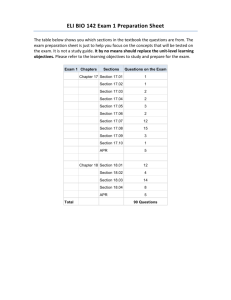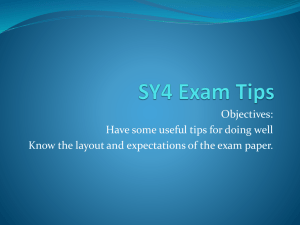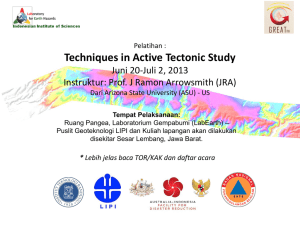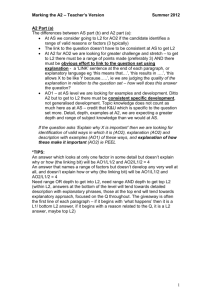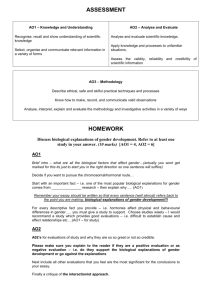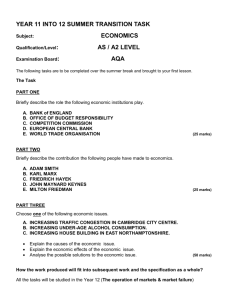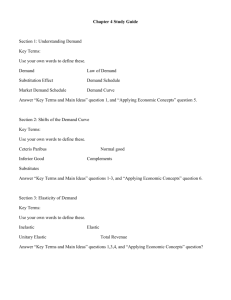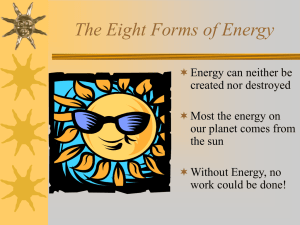Section 4: Elastic Properties
advertisement
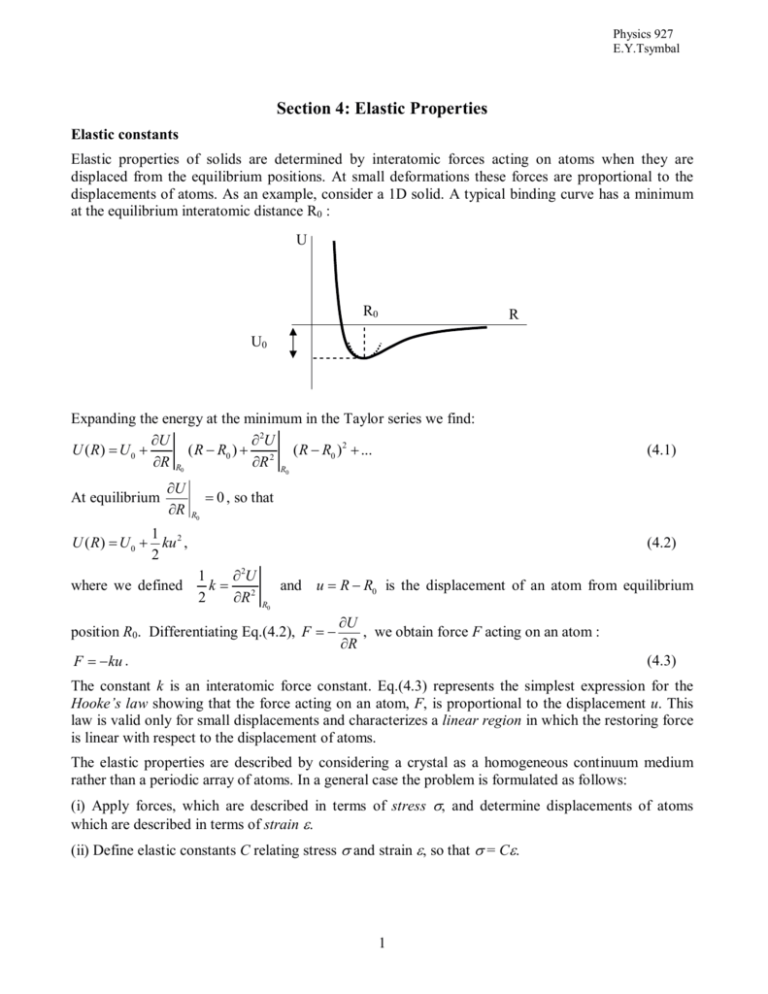
Physics 927 E.Y.Tsymbal Section 4: Elastic Properties Elastic constants Elastic properties of solids are determined by interatomic forces acting on atoms when they are displaced from the equilibrium positions. At small deformations these forces are proportional to the displacements of atoms. As an example, consider a 1D solid. A typical binding curve has a minimum at the equilibrium interatomic distance R0 : U R0 R U0 Expanding the energy at the minimum in the Taylor series we find: ∂U ∂ 2U U ( R) = U 0 + ( R − R0 ) + 2 ( R − R0 )2 + ... ∂R R0 ∂R R (4.1) 0 At equilibrium ∂U ∂R = 0 , so that R0 1 U ( R) = U 0 + ku 2 , 2 where we defined (4.2) 1 ∂ 2U k= 2 ∂R 2 and u = R − R0 is the displacement of an atom from equilibrium R0 position R0. Differentiating Eq.(4.2), F = − F = − ku . ∂U , we obtain force F acting on an atom : ∂R (4.3) The constant k is an interatomic force constant. Eq.(4.3) represents the simplest expression for the Hooke’s law showing that the force acting on an atom, F, is proportional to the displacement u. This law is valid only for small displacements and characterizes a linear region in which the restoring force is linear with respect to the displacement of atoms. The elastic properties are described by considering a crystal as a homogeneous continuum medium rather than a periodic array of atoms. In a general case the problem is formulated as follows: (i) Apply forces, which are described in terms of stress σ, and determine displacements of atoms which are described in terms of strain ε. (ii) Define elastic constants C relating stress σ and strain ε, so that σ = Cε. 1 Physics 927 E.Y.Tsymbal Example: In 1D case, F = − ku , where u is a change in the crystal length under applied force F. We can therefore write σ= F −kL = A A u = Cε , L (4.4) where A is the area of the cross section, and L is the equilibrium length of the 1D crystal. The stress σ is defined as the force per unit area and the strain ε is the dimensionless constant which describes the relative displacement (deformation). In a general case of a 3D crystal the stress and the strain are tensors which are defined as follows. Stress has the meaning of local applied “pressure”. It has components σ ij , showing that the force can be applied along 3 directions “i” and 3 faces “j”. The stress is defined locally, so that σ ij = σ ij (r ) . Compression stress ( σ xx σ yy σ zz ): y F σ xx = x , Ax x Fx (4.5) area Ax Shear stress ( σ xy σ yx = Fy Ax σ yx σ xz σ zx σ yz σ zy ): y , Fy (4.6) x area Ax Shear forces must come in pairs to conserve angular acceleration inside the crystal: σxy σyx That makes the stress tensor diagonal, i.e. σ ij = σ ji . (4.7) Strain determines relative atomic displacement: ε ij (r ) = dui , dx j (4.8) where ui is displacement in “i” direction and xj is the direction along which ui may vary. 2 Physics 927 E.Y.Tsymbal Compression strain ( ε xx ε xx = ε yy ε zz ): du x , dx (4.9) In a homogeneous crystal ε xx is a constant ε xx = Shear strain ( ε xy ε yx = du y dx u , where u is the change in the crystal length L. L ε yx ε xz ε zx ε yz ε zy ) : σyx y x , uy (4.10) Since σ ij and σ ji must always be applied together, we can define shear strains symmetrically: ε ij = ε ji = 1 dui du j + . 2 dx j dxi (4.11) Elastic constants C relate the strain and the stress in a linear fashion: σ ij = Cijkl ε kl . (4.12) kl Eq.(4.12) is a general form of the Hooke’s law. The matrix C in a most general form has 3×3×3×3=81 components. However, due to the symmetrical form of σ ij and ε ij - each of them have 6 independent components, we need only 36 elastic constants. There is a convention to denote these constants by Cmn, where indices m and n are defined as 1=xx, 2=yy, 3=zz for the compression components and as 4=yz, 5=zx, 6=xy for the shear components. For example, C11 = C xxxx , C12 = Cxxyy , C44 = C yzyz . Therefore, the general form of the Hooke’s law is given by mixed compression σ xx C11 σ yy C21 σ zz C31 = σ yz C41 σ zx C51 σ xy C61 stress C12 C13 C14 C15 C16 C22 C23 C24 C25 C26 C32 C33 C34 C35 C36 C42 C43 C44 C45 C46 C52 C53 C54 C55 C56 C62 C63 C64 C65 C66 mixed shear ε xx ε yy ε zz ε yz ε zx ε xy compression (4.13) shear strain 3 Physics 927 E.Y.Tsymbal All 36 elastic constants are independent. However in crystals many of them are the same due to symmetry. In particular, in cubic crystals C11 = C22 = C33 , C12 = C21 = C23 = C32 = C13 = C31 , C44 = C55 = C66 due the fact that x, y, and z axes are identical by symmetry. Also the off diagonal shear components are zero, i.e. C45 = C54 = C56 = C65 = C46 = C64 = 0 , and mixed compression/shear coupling does not occur, i.e. C14 = C41 = ... = 0 . Therefore, the cubic elasticity matrix has the form C11 C12 C12 C12 C11 C12 C12 C12 0 C11 0 C44 0 0 0 C44 0 0 0 C44 . (4.14) We have only 3 independent constants. Longitudinal compression (Young’s modulus): C11 = σ xx ε xx F/A = u/L F (4.15) u Transverse expansion: C12 = σ xx ε yy (4.16) u F Shear modulus: C44 = = σ xy ε xy F/A φ F (4.17) φ 4 Physics 927 E.Y.Tsymbal Elastic waves So far, we have assumed that atoms were at rest at their lattice sites. Atoms, however, are not quite stationary, but can oscillate around their equilibrium positions (e.g., as a result of thermal energy). This leads to lattice vibrations. When considering lattice vibrations three major approximations are made: (i) It is assumed that displacements of atoms are small, i.e. u a , where a is a lattice parameter. (ii) Forces acting on atoms are assumed to be harmonic, i.e. proportional to the displacements: F = −Cu . This is the same approximation which is used to describe a harmonic oscillator. (iii) It is assumed that the adiabatic approximation is valid – electrons follow atoms, so that the nature of bond is not affected by vibrations. The discreteness of the lattice must be taken into account in the discussion of lattice vibrations. However, when the wavelength is very long, i.e. λ a , one may disregard the atomic nature and treat the solid as a continuous medium. Such vibrations are referred to as elastic waves. We consider an elastic wave in a long bar of cross-sectional area A and mass density ρ = M / V . (1) First, we consider a longitudinal wave of compression/expansion. u A F(x) F(x+dx) x x+dx We look at a segment of width dx at the point x and denote the elastic displacement by u. According to the Newton’s second low d 2u m 2 = F, (4.18) dt which implies that d 2u ( ρ Adx) 2 = F ( x + dx ) − F ( x ) , dt ρ (4.19) d 2u 1 dF dσ xx = = , dt 2 A dx dx (4.20) where we introduced the compression stress σ xx . Assuming that the wave propagates along the [100] direction, we can write the Hooke’s law in the form σ xx = C11ε xx , where C11 is Young’s modulus. Since ε xx = (4.21) du , this leads to the wave equation dx 5 Physics 927 E.Y.Tsymbal d 2u C11 d 2 u . = dt 2 ρ dx 2 (4.22) A solution if the wave equation has the form of a propagating longitudinal plane wave u( x, t ) = A ei ( qx −ωt ) xˆ , (4.23) where q is the wave vector, ω = vL q , is the frequency, and vL = (4.24) C11 ρ (4.25) is the longitudinal velocity of sound. (2) Now we consider a transverse wave which is controlled by shear stress and strain. u y F(x) F(x+dx) x x x+dx In this case d 2u dσ xy ρ 2 = , dt dx (4.26) where the shear stress σ xy is determined by the shear modulus C44 and shear strain ε xy = σ xy = C44ε xy . du : dx (4.27) Therefore Eq.(4.26) takes the form ρ d ε xy d 2u d 2u = C = C , 44 44 dt 2 dx dx 2 (4.28) resulting in the wave equation d 2u C44 d 2u . = dt 2 ρ dx 2 (4.29) This is the equation for the transverse plane wave, which has displacements in the y direction but propagates in the x direction: u( x, t ) = A ei ( qx−ωt ) yˆ , (4.30) 6 Physics 927 E.Y.Tsymbal where q is the wave vector, ω = vT q , in the frequency, and vT = (4.31) C44 (4.32) ρ is the transverse velocity of sound. Note that there are two linear independent transverse modes characterized by the displacements in y and in z directions. For the [100] direction, by symmetry the velocities of these modes are the same and given by Eq.(4.32). Normally C11 > C44 and therefore v L > vT . Waves we have considered are in [100] direction, i.e. q || [100]. In other directions, the sound velocity depends on combinations of elastic constants: v= Ceff ρ , (4.33) where Ceff is an effective elastic constant which is given for cubic crystals in the table: Mode q || [100] q || [110]. q || [111] L T1 T2 C11 C44 C44 ½(C11+C12+2C44) C44 ½(C11−C12) (C11+2 C12+4C44) (C11−C12+C44) (C11−C12+C44) The relation connecting the frequency ω and the wave vector q is known as the dispersion relation. For elastic waves, ω is proportional to q, and the ratio ω/q gives a constant velocity. The figure below shows the dispersion relation for elastic waves. There are three modes – one longitudinal and two transverse, which represent straight lines whose slopes are equal to the respective velocities of sound. For the [100] and [111] directions the two transverse modes are degenerate, i.e. have the same vT. L ω T1 T2 kq 7
